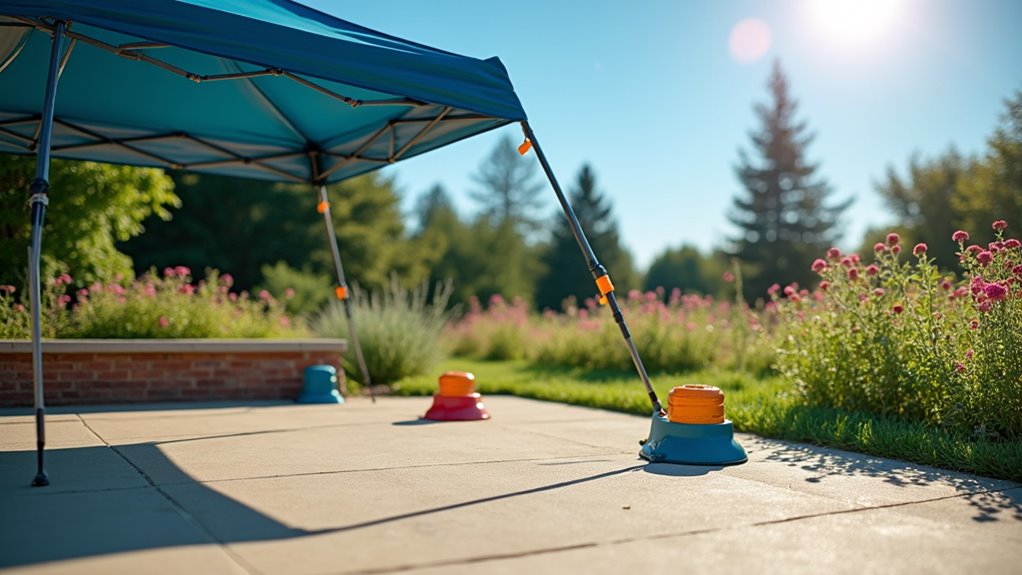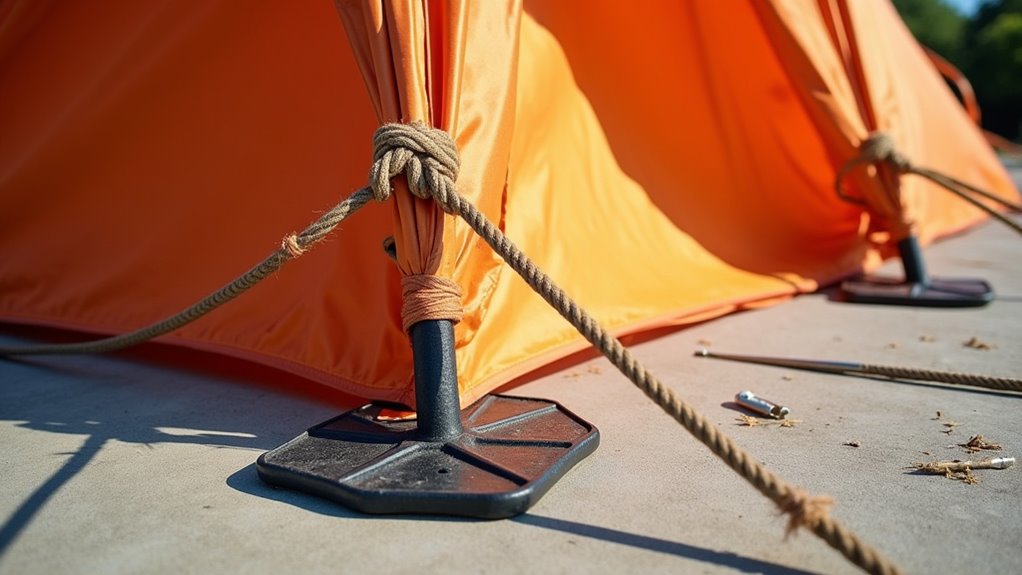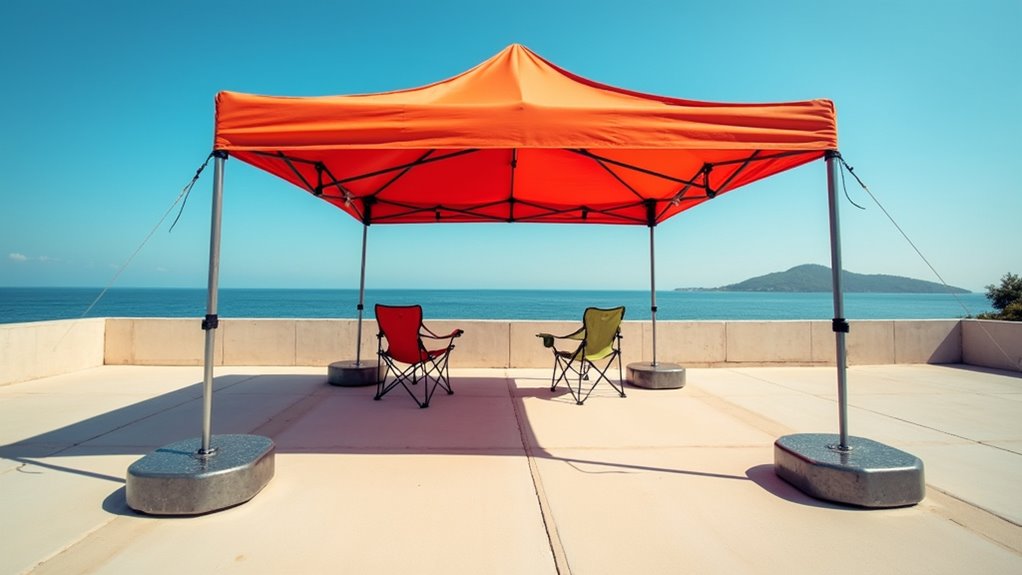How To Hold Down A Canopy Tent On Concrete
This post contains affiliate links. As an Amazon Associate, we earn from qualifying purchases.
To hold down a canopy tent on concrete, use heavy weights such as sandbags, concrete blocks, or buckets filled with gravel or concrete mix. Secure the tent by attaching ropes or straps to these weights, which can be connected to eye bolts or kettlebells. For more permanent setups, concrete anchors or hooked cinder blocks provide additional stability. Make sure the weights are evenly distributed across all tent legs to maintain balance. Further explanation and tips for an even sturdier setup will follow later in the article.
Essential Facts in 30 Seconds
- Use weighted bags filled with sand or water to secure canopy tent legs on concrete.
- Fill buckets with gravel or concrete mix to create heavy, movable anchors.
- Use strong ropes and straps to fasten the tent with even tension.
- Apply heavy-duty stakes or concrete anchors for added wind resistance.
- Distribute weights evenly on all tent legs for balance and stability.
Temporary Weight Solutions for Immediate Stability

Setting up a canopy tent on concrete needs strong weights for stability. Weighted bags filled with sand or water work well. They wrap around the tent legs and spread the weight evenly.
Concrete or cinder blocks, usually 25-35 lbs each, offer solid support. Attach them securely to the legs for best results.
Buckets filled with gravel or concrete mix also hold the tent steady. They’re easy to move and adjust.
Kettlebells and cast-iron footplates are small but heavy options. Make sure all weights stay tight to handle strong winds. This keeps your tent safe and protects the concrete below.
Permanent Concrete-Based Anchors for Long-Term Use
Permanent anchors keep your canopy tent safe on concrete for years. They stop the tent from moving or falling. Use strong, rust-proof materials to last longer. Place anchors evenly to spread weight well.
Try these options:
- Concrete-filled buckets: Heavy buckets filled with concrete hold the tent without harming the ground.
- Concrete frame screws: Screws drilled into concrete create a solid, tight hold.
- Hooked cinder blocks: Attach hooks to blocks for cheap, steady anchors.
- Special concrete anchors: Use designed anchors and strong footplates for top stability.
Plan your anchor spots carefully. Use tough materials. This keeps your canopy safe and steady over time.
Effective Anchoring Methods With Ropes and Straps

Securing your canopy tent on concrete requires strong ropes and straps. Tie buckets filled with sand or concrete to the tent frame. These buckets act as heavy weights and keep the tent stable. Water weight bags also work well. Fill them with water and strap them to the tent legs tightly.
For a stronger hold, add eye bolts to cinder blocks. This lets you fasten ropes securely. Heavy kettlebells make good anchors too. Loop a strap around their handles for a firm grip. Additionally, using guy ropes can enhance stability by distributing tension evenly across the tent structure.
Use tough straps to tie sandbags, so they don’t move in the wind. These easy methods keep your canopy steady and make setup quick and simple.
Heavy-Duty Stakes and Anchors for Enhanced Security
Heavy-duty stakes and anchors keep your canopy tent safe on concrete. Strong winds can move your tent. Using tough materials stops this from happening.
Steel or rebar stakes hold firm and last long. Concrete anchors, like expansion or wedge types, hold tight but need careful drilling.
Large concrete blocks or metal plates add weight without damage. Special stakes fit into cracks or holes for extra grip.
These tools make your tent steady and safe. Proper setup matters most for strong support.
Practical Tips for Setup and Mobility on Concrete

Set up your canopy tent on concrete with safety and ease in mind. Use plastic buckets filled with water or sand. Tie them to tent legs using bungee cords. This method keeps the tent steady and lets you adjust quickly.
For strong winds, use heavy concrete blocks or weight plates. Attach these with eye bolts or hooks for firm hold.
Choose containers you can empty to make moving easier. Place weights evenly on all legs to keep balance.
For a long-term fix, use concrete frame screws to secure your tent. Pick the method that fits your needs best. Keep your canopy safe without making setup hard. Additionally, ensure the site provides enough space for the tent and activities to avoid any crowding issues.
Frequently Asked Questions
Can I Use My Canopy Tent on Uneven Concrete Surfaces?
Using a canopy tent on uneven concrete is possible. Make sure the surface is clean and free of debris. Use heavy weights or sandbags to hold the tent down. Adjust each leg to different heights to keep the tent steady. This helps stop wobbling and keeps the tent safe. A stable tent lasts longer and protects you better from wind or rain. Stay careful and check the tent often during use.
What Is the Best Weight Option for High Winds?
Heavy-duty weights keep your canopy tent safe in strong winds. Use sandbags, water barrels, or steel weights. These stop the tent from moving or tipping over. A strong frame and wind-resistant design add extra protection. Secure all corners tightly to the ground. This setup helps your tent stay steady and safe during storms.
Can I Use a Canopy Tent on Grass After Concrete?
Using a canopy tent on grass is easy and safe after using it on concrete. Grass lets you push stakes into the ground. This holds the tent firmly. The tent stays stable even if the wind blows hard. Grass also stops the tent from sliding. Setting up the tent on grass takes less time. You get better safety and comfort outside.
How Do I Clean and Maintain My Anchoring Equipment?
Clean your anchoring gear with mild soap and water after each use. Rinse off salt, dirt, and sand to stop damage. Let the equipment dry fully before storing it. Keep anchors and ropes in a dry, cool place away from sunlight. Check for rust, cracks, or wear regularly. Replace parts if you find any damage. Proper care helps your gear last longer and keeps you safe on the water.
Are There Specific Regulations for Tent Weights in Public Spaces?
Tent rules demand strong weights and anchors for safety in public areas. Use heavy items like sandbags or water barrels, especially on hard floors. These weights stop tents from moving or falling during wind. Local laws often set exact weight limits to follow. Staying within these rules keeps everyone safe and avoids fines. Always check your city or event rules before setting up. Safety first.
Conclusion
Securing a canopy tent on concrete keeps it safe and steady. Use heavy weights like sandbags or water barrels to hold down the legs. Drill holes and install permanent anchors for long-term setups. Tie strong ropes to the frame and anchor points to stop movement. Heavy-duty stakes work well on soft ground but not on concrete. Adjust your setup if you need to move the tent often. These simple steps stop your tent from blowing away in wind. Protect your event with a solid, well-anchored canopy tent. Take a few minutes to secure it right.
